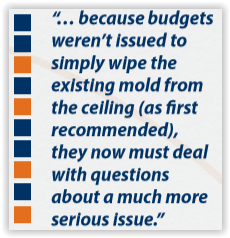Tale of 2 Buildings
WHEN PUTTING IT OFF PUTS YOU IN HOT WATER
 In 2014, I visited a building on the Texas Gulf Coast to see if the air quality was being affected by mold on the ceiling of a four-story atrium. This problem began in 2009, when an outdoor air vent was left wide-open over the weekend. This vent allowed large amounts of humid outdoor air into the building, only to turn into condensation when it cooled. The following Monday, people came to work to find it raining inside the building as condensation dripped from ceilings. Most of the ceilings were cleaned, except the atrium, which the building managers decided would be too expensive to reach. Unfortunately, as the atrium ceiling dried, mold developed on the surfaces.
In 2014, I visited a building on the Texas Gulf Coast to see if the air quality was being affected by mold on the ceiling of a four-story atrium. This problem began in 2009, when an outdoor air vent was left wide-open over the weekend. This vent allowed large amounts of humid outdoor air into the building, only to turn into condensation when it cooled. The following Monday, people came to work to find it raining inside the building as condensation dripped from ceilings. Most of the ceilings were cleaned, except the atrium, which the building managers decided would be too expensive to reach. Unfortunately, as the atrium ceiling dried, mold developed on the surfaces.
Since that time, two separate consultants confirmed that same mold on the ceiling, though their reports stated the mold wasn’t airborne. Rather than clean it up as recommended, management put off addressing the problem, always claiming they would find room in the budget “next year.” I heard this budget excuse myself when I insisted the mold needed to be cleaned up in 2014. This past May, I was called out to address a different IAQ issue and was asked to look at the mold again. This time, a woman whose company occupies the top two floors of the building said to me, “We can’t help but wonder if the mold on the ceiling is the reason a lot of us have been diagnosed with cancer in the last five years.”
To be clear, I am not aware of any research that indicates mold causes cancer. However, because budgets weren’t issued to simply wipe the existing mold from the ceiling (as first recommended), they now must deal with questions about a much more serious health issue. Management will now have to meet with occupants in an emotionally-charged atmosphere to address the cancer concerns.
Struggling with budgets to address this kind of hot-topic issue is the complete opposite of the proactive response recently displayed by the manager of a different high-rise. When five people complained about feeling sick while in the building, the building manager wasted no time. She spoke with the tenants in person and took a look around the spaces herself. Three days after receiving the complaints, the manager and her staff had not found any problems, so she called us to come out and use our experience to investigate.
 After our inspection and some simple air tests, we recommended a number of changes that could be done to improve air quality. These included cleaning carpets, removing piles of papers so the custodians could clean office areas, getting rid of overwatered plants (which were growing mold), and moving desktop printers off desks so they wouldn’t kick chemicals and powdered ink into the air next to someone’s face. The manager and tenant both agreed to correct these problems, and we made plans to return at a later time to check the air quality for improvements.
After our inspection and some simple air tests, we recommended a number of changes that could be done to improve air quality. These included cleaning carpets, removing piles of papers so the custodians could clean office areas, getting rid of overwatered plants (which were growing mold), and moving desktop printers off desks so they wouldn’t kick chemicals and powdered ink into the air next to someone’s face. The manager and tenant both agreed to correct these problems, and we made plans to return at a later time to check the air quality for improvements.
There’s a right way to handle IAQ in your building, and there’s a wrong way. The first example shows how ignoring your problems can cause them to grow. The other shows the benefit of a manager and tenant working toward a common goal. When you do everything in your power to correct a potential problem, your tenants feel better knowing you’ve heard them, and in the end, you protect yourself from future complaints or claims.

